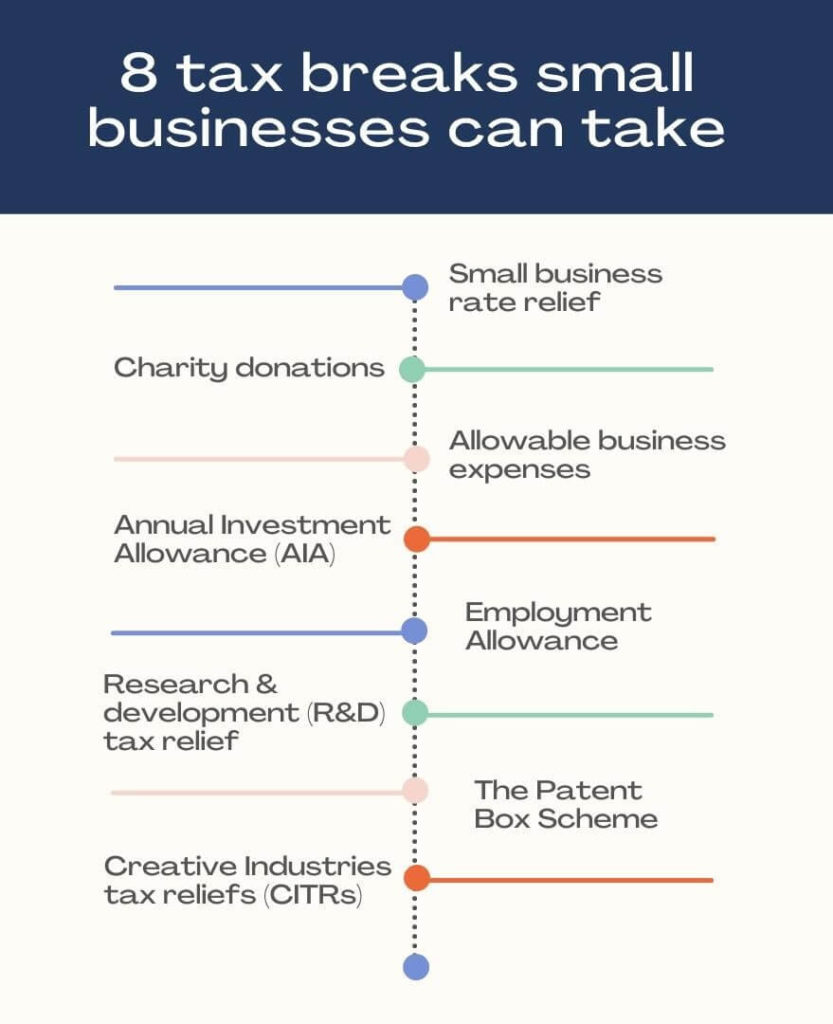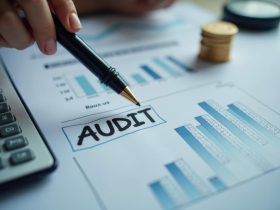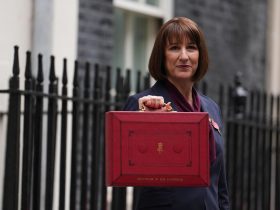It’s a difficult time to be a small business owner, and it’s always worth looking for methods to make things easier financially. When you manage a small business, you have a lot of expenses to cover, but there are a few methods to recoup part of the tax you pay.
Identifying all of your expenses and those that are tax-deductible for your small business is one of the simplest methods to make your firm more profitable.
We’ve compiled a list of 8 tax reliefs that small businesses can claim to assist you in reducing your tax burden.
Table of Content
What does a tax break mean?
A tax break, also known as tax relief, is a way for you to decrease your tax liability by accounting for expenses or investments you make for your business.

It’s a way for the government to stimulate economic activity by giving you additional money to spend on your business. It also encourages productive behaviours like investment in innovation.
Taking advantage of tax benefits is not tax avoidance, tax manipulation, using a tax loophole, or paying less than you owe.
Following are the tax breaks your business can use to reduce your overall tax liability, or if it is a loss-making business, to increase carryforward losses:

1. Small business rate relief
For non-domestic or business property, most enterprises with their premises are charged a ‘business rate‘ by their local council. The government established the Small Business Rate Relief plan (SBRR) in 2005 to help small firms with their premises.
Following are the eligibility criteria for SBRR:
- one property with a rateable value of not more than £15,000; or
- with multiple properties, non of the properties have rateable values of more than £2,900, and the total rateable value of all properties is less than £20,000.
Rate relief is 100% up to £12,000 and tapered between £12,000 to £15,000.
If the rateable value is above these thresholds but below £51,000, you may still get rate relief, but it won’t be as generous.
How to apply for Small Business Rates Relief
Contact your local council and fill out a rate relief application form to determine if you’re qualified for SBRR and apply it.
Specific properties, including agricultural lands and structures, places of worship, and buildings used for the training or welfare of disabled people, are exempt from paying any business rates.
While the principle is the same, business rates are handled differently in England, Scotland, Wales, and Northern Ireland, so check your local government’s website.
2. Charity donations
There is no tax on individual contributions to charity in the United Kingdom. Charities or Community Amateur Sports Clubs can collect the introductory tax rate paid by donors from HMRC if they are registered for gift aid scheme.
For every £1 you donate, a charity or sports club will receive an additional 25p at no further cost.
How to claim tax relief for charity donations
Suppose you’re enrolled for Self Assessment and pay income tax at a rate higher than the introductory rate of 20%. You can claim the difference between the tax you paid on Gift Aid donations and the amount the charity received back when you file your Self Assessment tax return.
Businesses are entitled to tax relief for qualifying charitable donations made to charities. The tax deduction can only be made up to the amount that brings the company’s total taxable profits to zero: a charitable donation cannot be used to create or increase a loss for tax purposes.
3. Allowable business expenses
Regardless of size or industry, every small business has operating costs or expenses to keep the business functioning and competitive.
Allowable business expenses assist in managing some of these operating costs by allowing you to deduct the charge from your taxable income or profits.
Example of allowable expenses is salaries, employer NIC contributions, travel costs, accountancy fees, marketing and advertising costs, rent, business rates etc.
How to claim tax relief for Allowable expenses
Allowable costs can be stated on your Self Assessment tax return if you’re self-employed or CT600 tax return in the case of a company. The allowable expenses are deducted from income or profits to arrive at taxable income or profits.
Taxable incoome or profits = Income/ turnover – business expenses
A detailed record for up to six years must be maintained.
4. Annual Investment Allowance (AIA)
Whereas permitted expenses allow you to deduct costs associated with day-to-day operations, the Annual Investment Allowance (AIA) will remove major purchases of items you intend to maintain and utilise in your firm.
Most machineries are eligible for AIA up to a certain sum. This amount is £1 million until December 31, 2020, but it varies year to year, usually significantly, so you should investigate allowances before making any significant purchases.
How to claim Annual Investment Allowance
In the accounting period in which you purchased the item, you can claim AIA on your Company Tax Return, which HMRC defines as:
- The date you signed the contract if payment is due within four months
- The date payment is due if due more than four months later
You may have to pay additional tax in the accounting period of sale if you sell an item after claiming AIA.
5. Employment Allowance
If you own a business and employ people, you may be able to save up to £5,000 (£4,000 until the tax year 2020-21) on your National Insurance (NI) bill by taking advantage of Employment Allowance.
It works by lowering your employer NIC every time you process payroll until the £5,000 is deducted or the tax year has ended, whichever comes first.
For example, if pay an employee a salary of £40,000 per year and pay the standard employer NI at 15.05%. Your annual employer NI for 2022-23 will be £4,650.45
You won’t have to pay any Employer NICs because the £5,000 Employment Allowance covers the total sum (£4,650.45).
How to claim Employment Allowance
If your business or charity had employee Class 1 NI liabilities of less than £100,000 in the preceding tax year, you could claim Employment Allowance.
If you hire care or support workers, you can also get a tax break.
If you’re eligible, Employment Allowance will be deducted from your Class 1 NICs automatically via payroll software or by checking the Employment Allowance box.
6. Research and development (R&D) tax relief
Businesses in the United Kingdom spent £37.1 billion on research and development in 2018, accounting for 1.7% of GDP. The government wants that amount to be 2.4% of GDP by 2027.
To encourage small firms to participate in R&D, the government gives Corporation Tax Relief, which allows companies to deduct an additional 130% of qualifying costs from their yearly profit, in addition to the regular deduction of 100%, for a total tax deduction of 230%
If you spend £1,000 on R&D, you can deduct an additional £1,300 from your taxable income each year.
Ways to claim Research and Development tax relief
Your company must employ less than 500 people and have a turnover of less than €100 million or a balance sheet of less than €86 million to be eligible for R&D tax reliefs.
If you meet the criteria, you’ll be eligible to claim lower tax payments. Relief is available for up to two years following the end of the relevant accounting period.
To claim R&D tax reliefs, fill out the enhanced expenditure section of your complete Company Tax Return form.
7. The Patent Box Scheme
The Patent Box program, like R&D tax relief, stimulates innovation and rewards forward-thinking businesses with a Corporation Tax discount.
Businesses who retain and commercialise the existing UK and European patents or develop new patented items are eligible under the scheme. Since April 1, 2013, if your business matches the conditions, you’ll be able to take advantage of a reduced Corporation Tax rate of 10% on all earnings produced from patented ideas.
And the discount is substantial. The Patent Box scheme provided £1,035 million tax relief to 1,170 enterprises in 2016-17.
How to claim Patent Box tax relief
You must make an election into the Patent Box within two years of the end of the relevant accounting period to get the Corporation Tax reduction. It can be done as part of the computations that come with your Company Tax Return or separately in writing.
Calculating your qualifying profits and income, on the other hand, can be difficult.
IP rights, patented items, and product families must all be streamed individually, according to new guidelines announced in 2016 to protect the system from exploitation.
8. Creative Industries tax reliefs (CITRs)
The government introduced Creative Sectors Tax Reliefs in 2013 to stimulate long-term investments in the UK’s creative industries.
They’ve been well-received. In 2019-2020 it gave £1.11 billion in tax relief across all creative industries, including:
- Film
- High-end TV
- Animation
- Video games
- Children’s TV
- Theatre
- Orchestra
- Museums and Galleries Exhibition
CITRs are comparable to R&D tax benefits in that they allow research and development expenses exclusion from trade earnings.
It implies you can claim an additional Corporation Tax discount (the enhancement) of up to 100% of enhanceable expenditure if you qualify. Alternatively, if you lose money, you can claim 25% of the loss up to the amount of enhanceable cost.
How to claim Creative Industries tax reliefs
For each industry, the method of claiming CITR is essentially the same. You may do it by determining the amount of additional deduction and payable credit you owe on your Company Tax Return.

Final thoughts
Various tax reliefs are available under the UK tax system to stimulate investment in UK businesses. How tax relief grants take place, and the necessary mandatory conditions differ significantly.
Follow the above steps to take advantage of tax breaks to help you free up funds and invest in growth opportunities.










Leave a Reply